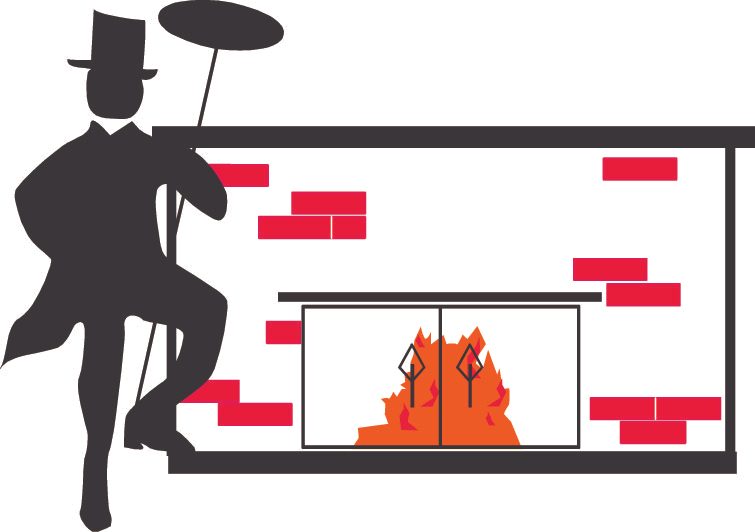Creosote is a natural byproduct of burning wood. When a wood fire is burning, there needs to be enough oxygen to have proper combustion so that the wood smoke can go up and out of the chimney flue. Creosote comes from condensed wood smoke, which occurs when wood smolders—when its airflow has been reduced or restricted, or when there is too much airflow which causes the wood smoke to cool down too fast, resulting in condensation and creosote deposits inside the flue . This condensed wood smoke is made up of tar droplets, vapors, and other organic compounds. As the tar droplets and vapors rise up the flue, they condense as a liquid onto the inside of the chimney because there is not enough heat to carry them up and out.
Normal soot deposits are soft and black/brown in color. Creosote deposits are usually dark brown or black in color. They can appear watery or tar-like depending on the mixture of tar and vapors. Once inside the chimney, creosote often changes form because of pyrolysis (the chemical alteration of fuel molecules as a result of heat).
Sooty, ash-like deposits are common in fireplaces. The soot is often mixed with fly ash (ashes that are carried up into the flue by the draft). This type of creosote is often referred to as Class 1 creosote. While these deposits are less combustible than other forms of chimney deposits, they still present a fire hazard. Regular sweeping helps to prevent flue blockages, moisture retention, chimney odors, and most importantly, chimney fires.
Class 2 creosote looks like dry, flaky black deposits and are the result of tar deposits that have been heated and pyrolyzed. This type of creosote ignites easily and can cause a significant chimney fire.
The worst type of creosote is the hard, shiny black deposits. They are a form of tar glaze that has been baked onto the chimney flue walls. These deposits are more difficult to ignite. However, if they do ignite, they would burn at extremely high temperatures, which could cause significant damage to the chimney and the home.
There are several variables that contribute to build up of creosote: Smoke Density, Flue Gas Temperature, and Residence Time. Smoke density refers to the amount of unburned hydrocarbons in the wood gas. Generally, the smokiest fires produce the most amount of creosote. Low air supply causes high smoke density. “Banking” a wood stove (filling the stove with wood and then reducing the air flow so that the fire “burns”/smolders all night) oftentimes results in the accumulation of creosote. Flue Gas temperature refers to the temperature of the gases entering the chimney. The flue gas temperature is influenced by the chimney type, its size and location, and by the appliance type and usage. For example, uninsulated chimneys located on exterior walls of a home are colder than those that are located on the interior walls or those that are insulated. Colder chimneys cool the smoke vapors, which results in the vapors condensing and depositing creosote on the interior of the chimney. Residence Time refers to the length of time the smoke is in the venting system/flue. If the area of the flue is too large, the flow rate of the smoke will be slow. The smoke will remain in the chimney longer, allowing it to cool, condense, and deposit creosote.
The primary reason creosote should be removed is to reduce the possibility of a chimney fire. All chimney fires are extremely dangerous. During a chimney fire, the temperature in the flue can exceed 2000 degrees Fahrenheit. Flames can come out of the chimney top or travel through cracks in the chimney walls and ignite the roof or other parts of the house as well as nearby bushes and trees. The high heat of a chimney fire can damage chimney liners, crack chimney walls, and damage factory-built metal chimneys.
Oftentimes, there are signs that you are having a chimney fire:
- There is a loud noise. Some folks say it sounds like a train or a jet airplane during takeoff. Some folks don’t hear any noise.
- You will see sparks and flames coming out of the top of the chimney.
- If you have a wood stove, the connection to the flue may glow red-hot, the connector and/or the stove may vibrate, and flames will be visible through tiny cracks in the connector.
- Smoke and odors will be noticeable in adjoining rooms or in the attic.
If you think you are having a chimney fire …
- Alert people in your house about the fire.
- Call the fire department or 911.
- If you have a wood stove or wood stove insert, quickly shut any doors and inlet dampers to deprive the system of air. Only do this if you can do it safely!
- Afterwards, have the chimney inspected as soon as possible by a Certified Chimney Sweep before using it again to make sure the flue and/or chimney has not been damaged.
